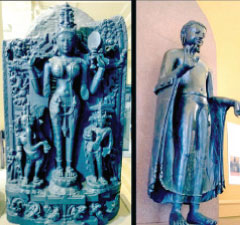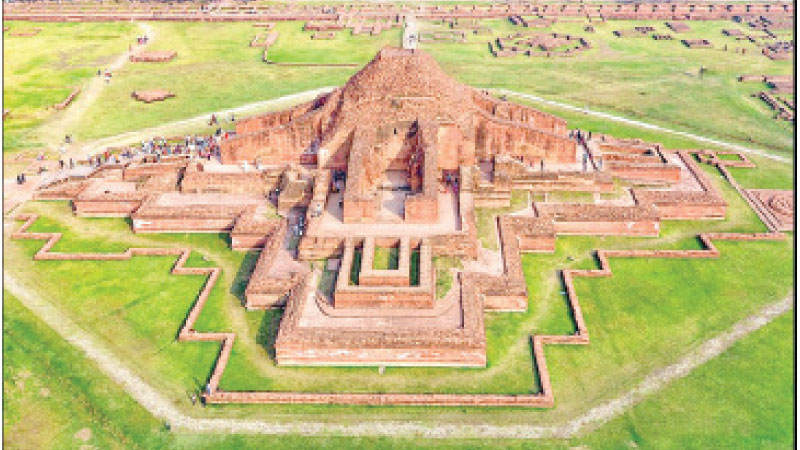The Palas, who ruled North India from the 8th to the 12th Century deserve credit for spreading Mahayana Buddhism and making social welfare an essential ingredient of State policy.
When one talks of the great Indian Buddhist Emperors, only Ashoka(268-232 BCE) and Kanishka (127-150 CE) are mentioned. The Bengal-based Pala Empire (750 to 1120 CE) is ignored.
One of the reasons for this is the shifting of the centre of power in India from the East to the North during the rule of the mighty Moghuls. The British, who followed the Mughals also shifted their headquarters from Calcutta in the East to Delhi in the North. Indian and foreign historians’ followed suit by shifting their focus from other parts of India to the centre of power in Delhi. Thus, the history of India became the history of Delhi and North India essentially.
 This has been so despite the vastness of the Pala empire, its seminal and numerous contributions to Mahayana Buddhism, State administration, social welfare and religious tolerance.
This has been so despite the vastness of the Pala empire, its seminal and numerous contributions to Mahayana Buddhism, State administration, social welfare and religious tolerance.
Like the Emperors Asoka and Kanishka, the Palas also ruled over vast areas of North India over 400 years, albeit with varying degrees of effectiveness. More importantly, they imparted Buddhist values to their base, namely, Bengali society. To this day, Bengali historians, both in India and Bangladesh,Hindu and Muslim, laud the Palas’ contribution.
The Palas instilled in their subjects, the equalitarian values of Buddhism at a time when the hierarchical and Brahmin-dominated caste system was entrenched in the rest of India.
Saksham Jainin his paper on the Palas(International Journal of Integrated Studies and Research, Volume 1,Issue 4) the Pala Empire originated in Bengal and then spread to cover Gandhara(now in North-West Pakistan), the Kabul Valley in Afghanistan, Sindh in South Pakistan, Western Maharashtra,Bihar, Orissa and even Nepal.
Founded in 750 AD by Gopala, the Palas brought durable peace and stability to strife-torn Bengal and North India They were great patrons of Buddhism, even though the majority of their subjects were Hindus. They saw to it that Hindus and Buddhists lived in harmony.
Shashanka’s rule
Though Buddhist, the Palas were not pacifist. They used raw military power to establish themselves across North, East and Central India. They appeared on the scene in response to the yearning among the people of Bengal for relief from the violence and chaos which marked the end of king Shashanka’s rule. Shashanka was the first major Bengali king. His iron-fisted rule ensured peace. But following his death in 636 CE, Bengal lapsed into Matsya Nyaya (Rule of the Fish or Anarchy). But as history tells us, anarchy invariably paves the way for the emergence of a strong ruler. And the strong ruler who emerged was Gopala, who founded the Pala dynasty in 750 CE.
But Gopala did not become the ruler by the force of arms. The chieftains of Bengal got together and elected Gopala as the ruler of Bengal.
“This event has a unique place in the history of ancient Bengal, where power was sacrificed without any conflict between independent political chiefs,” Saksham Jain writes.
A copper plate of the era recorded the event thus: “To put an end to the state of affairs similar to what happens among fish, Prakriti (nature) made the glorious Gopala, the crest jewel of the heads of kings, take the hand of Lakshmi, the goddess of fortune.”
Gopala was an expansionist, conquering Magadha in Bihar, from where Emperor Asoka ruled his vast empire earlier. Gopala ruled till 770 CE, leaving a consolidated Empire. He was succeeded by his son, Dharmapala who was even stronger than Gopala and is regarded as one of the greatest kings of the Pala dynasty.
Dharmapala battled the Pratiharas and the Rashtrakutas of the Deccan (South India) valley and eventually took over the whole of Bengal and Bihar. He ventured to Kannauj (now in Uttar Pradesh) and Gandhara (now in North West Pakistan) extracting tributes. The rulers of parts of Rajasthan, Maharashtra, Punjab,Gujarat, Himachal Pradesh and even Nepal accepted Dharmapala’s suzerainty. He then assumed the grandiose title: Parameshwara Parama Bhattaraka Maharajadhiraja.
Ascended the throne
Devapala, Dharmapala’s successor ascended the throne in 810 CE. Being a skilled military leader he launched expeditions to the Vindhyas (hills dividing North and South India) and took on the Dravidas (southern kings). He also took on kings of Kamboj In Afghanistan. In the East he subdued Assam and Orissa.The Pala Empire was at its pinnacle.
After the death of Devapala , the Pala empire started crumbling. But in the 10th Century, it saw restoration under Mahipala. However, in the 12th Century, a series of invasions from the West and South and the rise of new powers such as the Varmans in Bengal itself weakened the Palas. But unwilling to be subdued, the Palas rose again under Ramapala who revived the Pala empire.
Ramapala was a great ruler, setting up an efficient administration, reducing taxes and promoting cultivation. But with his death in 1120 CE, it was curtains down for the Palas.
Non-political Achievements
In their 400-year rule, architecture witnessed great progress, Jain says. The Buddhist Vihara in the Somapurain Rajshahi district of Bangladesh was constructed by Dharmapala. The Somapura Vihara influenced temple architecture in Burma and Java. Thanks to the Palas, Mahayana Buddhism became a dominant sect in the Indian subcontinent, Tibet and even in the Malay Archipelago.
The first Pala ruler, Gopala, built the monastery at Odantapuri in Bihar. Dharmapala founded the Vikramsila monastery in Magadha (Bihar). Many Sanskrit texts were translated into Tibetan there.
Dharmapala’s successor, Devapala, restored the decaying Somapura Vihara in Paharpur in Bangladesh. King Balaputradeva of the Sailendra dynasty of Indonesia sent an Ambassador to the court of Devapala with a request to grant five villages for the maintenance of a monastery built by him at Nalanda (Bihar). The request was granted. Devapala appointed Veeradeva, a learned Brahmin-Buddhist as the head of the Nalanda University. During the reign of the Palas, many Tantric Buddhist works were produced. The Palas helped in the evolution of the Bengali language. ‘Proto Bengali’ was developed during the reign of Dharmapala.
Bangladeshi historian A. M. Chowdhury writes in the Banglapedia that the Palas built an efficient structure for revenue collection. The long list of state-officials, found in the Pala copper plates, clearly indicate that the administration was taking care of every aspect of public life. Dharmapala and Mahipala are known to have built irrigation tanks. Mahipala established towns.
The Arts
Terracotta plaques recovered from Paharpur amply demonstrate the excellence of the Arts in the Pala period. These plaques, used mainly in surface decoration of walls have been recognised as a unique creation of Bengal artists, Chowdhury says.
“Side by side with the depiction of religious subjects, the artists have chosen subjects from the everyday life of the people and hence their importance as a source of social history cannot be over- emphasised,” he added.
Sculpture flourished under the Palas. Bronze sculptures of Bengal came to be recognised as specimens of a matured art and specialists think that the Bengal bronzes influenced the Arts in South-East Asian countries.
Literature
The 9th Century work Ramacharitam composed by poet Abhinanda in the Vaidarbhi style, made a mark in Indian literature. Chakrapani Datta, son of Narayanapala’s officer Narayana Datta, authored a few medical treatises such as Chikitsa Sanggraha, Ayurveda dipika, Bhanumati, Shabda Chandrika and Dravyaguna sanggraha. The 12th Century medical treatise Shabda Pradipa was written by the royal physician Sureshvara, whose father, Bhadreshvara was Ramapala’s physician. Sureshvara’s other works include Vrikshayurveda and Lohapaddhati. Vangasena, the author of Chikitsasara Sanggraha and Gadadharavaidya, wrote a commentary on Sushrata Shastra.
However, all said and done, the most glorious aspect of the Pala rule was their promotion of inter-religious tolerance, Chowdhury said.
“There is no doubt that Hindu gods and goddesses and Brahmins received liberal patronage from the Pala rulers, though they themselves were devout Buddhists.There is no evidence of any religious discord between the Buddhists and the Hindus in the society under the Palas,” Chowdhury wrote.
Buddhism reigned in Bengal till the Senas, from Karnataka in South India, who were Hindus zealots, replaced the Palas, taking advantage of the latter’s decline after the death of king Ramapala.
The Senas reinstated Brahminism and its caste system with a vengeance. This is said to have been one of the factors pushing the down-trodden peasantry of East Bengal to switch to the more egalitarian Islam under Turk and Mughal rule between the 12th and 16th Centuries. The Senas thus had a hand in the creation of the communal divide in Bengal and the eventual partition of Bengal on religious lines in 1947.









